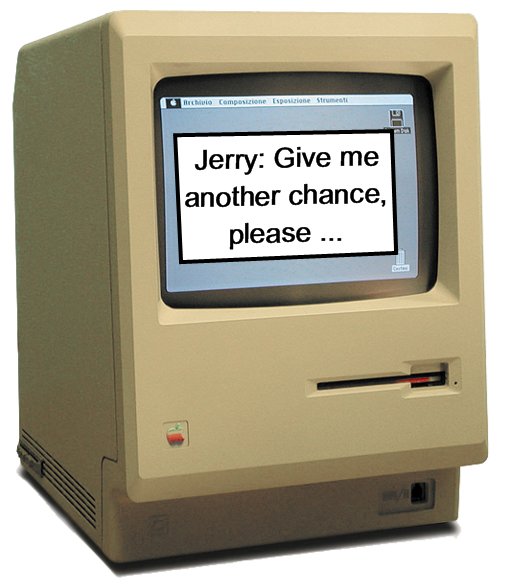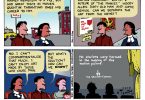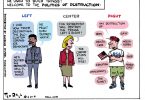aNewDomain.net — The Mac, unveiled January 25, 1984, introduced a whole generation of people to a kinder, easier method of computing. Or so the lore goes. Our Jerry Pournelle, by that point already a decade into his career as an acclaimed tech commentator, remembers the Mac differently. And he was not impressed with the slow, limited machine that ran way too hot …
I had a lot to say about the Apple Macintosh when it first came out back in 1984.

In my column in BYTE, I wrote that the Mac was little more than a toy computer — with a wonderful operating system attached. You might remember that first Mac was the 128K Mac. When I wrote up my thoughts, Steve Jobs (the late Apple CEO) was furious with me. But I’ll get back to that in the minute.
It’s true that when the Mac matured it became a great machine and caught up with the lofty visions Apple had for it. But the original Mac? That was a toy. This was true also for the original Apple Lisa.
You see, back then in the primeval days of computing, Apple was fighting for market share against the IBM PC running DOS, as well as popular S-100 systems running the DOS progenitor, CP/M. And competing with everyone else.
It was a real contest with no sure winner.
But Apple had anticipation going for it. Just before the Mac came out, all sorts of folks were looking forward to the next Apple machine, whatever it would be. Everyone was already incredibly impressed with the Apple II. Would the new system be an Apple III? Or would it be something entirely different, something that followed the Apple Lisa, maybe? Everyone at BYTE, anyway, was waiting to see.
As for me, I had already been playing with the Apple Lisa. It was just so slow. I hoped we wouldn’t get more of that silliness.
But then the original Mac came out. It was worse than even I expected.
No doubt, that first Mac was easy to use. But it cost a whopping $2,500. That was a lot to pay for a system — especially a system that was limited to 128KB of memory and had a CPU saddled with all the visual processing work.
Boy, was it slow.
I wrote that it was impossible to get any work done on it.
And the original Mac ran hot.
Any work you did on it was in constant danger of vanishing. That’s how hot it ran. The heat it generated resulted from Steve Jobs’ decision to not put a fan inside the system.
Also, there was no mass storage. Nothing but a single 3.5-inch floppy drive. And you had to boot the Mac from a floppy and then swap out that root system diskette if you wanted to run an application.
Sure, you could buy an external disk. Apple offered one. But the cost for the external disk started at half a grand.
I brought these concerns to then-CEO Jobs. He was adamant that I was wrong — and that the Mac didn’t need any improvement at all.
He thought it was wonderful. He thought 128 kilobytes of RAM is all a reasonable person would need.
I disagreed. Intensely. And so I ended up reaching the conclusion and writing a column — for BYTE, back then — that the Mac was a toy. A toy attached to a wonderful operating system.
Because I said this publicly, Apple executives, including Steve Jobs, were enraged. And in fact, my relationship with Apple steadily deteriorated until Pepsi’s John Sculley replaced Steve Jobs as CEO a bit later.
Before the Mac, Apple had a lot of business users. Remember that the first successful spreadsheet program, Bob Franklin and Dan Bricklin’s VisiCalc, was written for an Apple computer. People back then were racing to computer stores — not to get an Apple Mac but to “buy a VisiCalc,” odd as that sounds now. They didn’t care what the personal computer running it was going to be.
They all just wanted that spreadsheet.
As a result of the Mac’s slow speed and heat problems — and its lack of expansion capabilities — Apple ended up losing the loyal base of business customers it’d built with the Apple II.
But the Mac operating system software was far superior to Microsoft DOS, which was powering the competing IBM PCs. It was superior to Microsoft Windows, the graphical environment Microsoft set on top of DOS a few years later. It had a better text editor, too.
But the original Mac was slow, overpriced and way under-powered.
By the time Apple set all that right and got its hardware on track with its advanced operating system and interface, IBM-compatible MS-DOS based systems already had gained a huge lead in market share and for the hearts and minds of business users.
It’s true that, while losing business customers, the Mac did great in areas like publishing and graphics. And it had better speech synthesis tech than anything available at the toe — up to and including the big mini and mainframe computers that rules the world just a decade before Mac’s 1984 appearance. of just about anything available–up to and including big mini and mainframe computers.
And when, finally, the Mac maneuvered past its early hardware limitations, it became a likable system. And Apple, which was suffering and in death spasms by the late 1990s, had a great resurgence when the late Jobs returned and introduced the Apple iPhone, iPad and all the other iStuff.
So fortunes reversed. But the original Mac — hot and slow as it was — sure wouldn’t have been anyone’s bet for the computer of the future. That just wasn’t something the late Apple cofounder Steve Jobs wanted to hear.
For aNewDomain.net, I’m Jerry Pournelle.
Original image credit: Wikimedia Commons, parody elements added by aNewDomain graphics staff.













I remember when the Mac was announced. A newly opened ComputerWorld next to my office hosted an open house to herald the event. They joyously offered refreshments. This colorful event also attracted residents of a nearby retirement community. I recall seeing one of the elderly guests, perhaps his first experience with a computer, trying to work with “a computer so easy to use it doesn’t need an instruction guide.” He was holding the mouse upside down in his left hand and manipulating the ball with his right index finger. He became very frustrated at how the cursor moved backward ;)
[…] Jan. 24, 2014 marks the 30th anniversary of Apple’s release of the original Apple Macintosh. After I read our Jerry Pournelle’s bittersweet memories of that first machine today, I came up with the My First Mac essay writing contest. Here’s the deal. You write […]
From anewdomain’s Larry Press via Google+
That article took me back! I wrote a review of the Mac (in Abacus, a Springer Verlag magazine) when it first came out. A couple of quotes from that review sum up my reaction at the time:
“When I took the Mac on a visit to my father’s home, I could not get him to stop playing with it. He has had ample opportunity to use other personal computers — even some with mice — but has barely been willing to sit still for a short demonstration. With the Mac, he started by himself, drew silly pictures, wrote silly words, and had a good time…”
That was the good news, but I also wrote:
“Now for some bad news. Although this review is about the Macintosh, I am writing it on an IBM PC.”
The rest of the article was an in-depth (8-pages) review of the Mac, which included the same shortcomings as Jerry noted, but concluded that it was an important step and the hardware limitations would soon be overcome.
I followed that review with articles on the hard disk Mac and the MAC II — as well as an article (in the Communications of the ACM) putting the Mac in context when MS Windows finally became usable (version 3.11).
The CACM article is online, but not the Abacus articles.
Jerry, you’ve inspired me — I’ll scan and post them — hopefully some time next week!
Larry Press
[…] the interest of balance I’d also recommend you read Jerry Pournelle’s article Why the Original Mac Just Didn’t Cut It. It’s true the original Mac was woefully underpowered to handle that revolutionary operating […]
[…] — On the 30-year anniversary of Apple’s announcement of the original Apple Mac, I read our Jerry Pournelle’s memories of that 1984 machine. In Why the Original Mac Just Didn’t Cut It, Jerry talks about […]
[…] about the lucky guy who found in a garage sale for $15 an original Apple I with Steve Wozniak’s autograph and documentation signed by Steve Jobs? Sometimes it’s […]
Yes, Macs do tend to slow down strangely sometimes. However, there are various things like PRAM resets, SCM resets and a few other tricks that can bring it back to normal in a jiffy! http://machmachines.com/macbook-pro-running-slow-heres-how-to-fix-it/